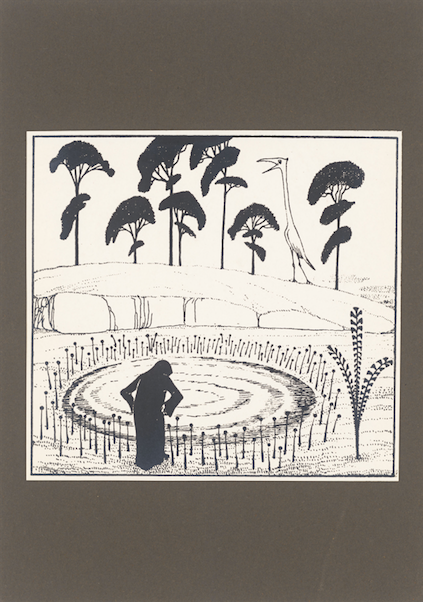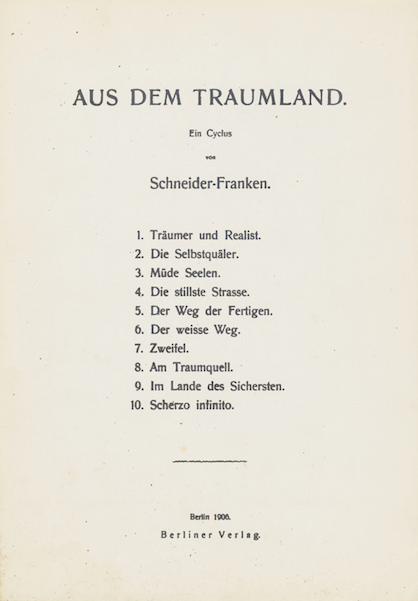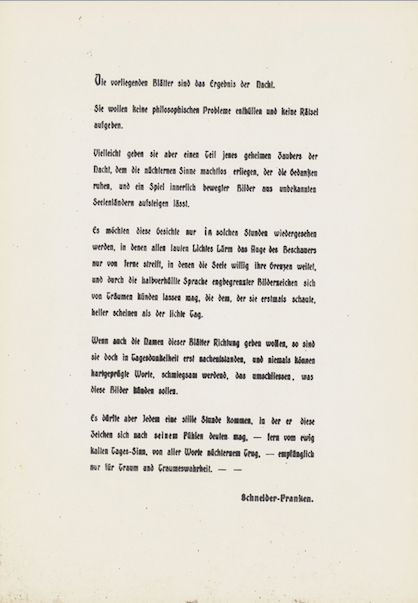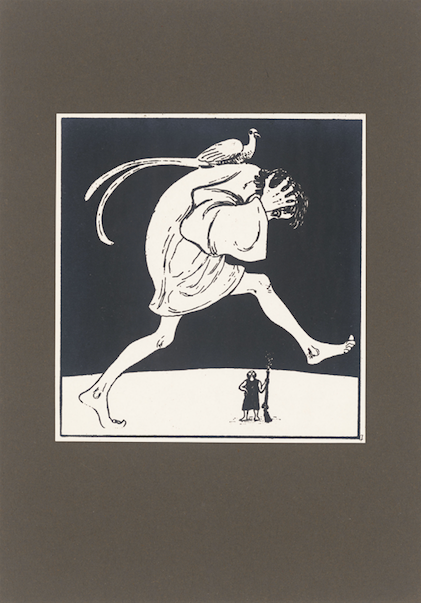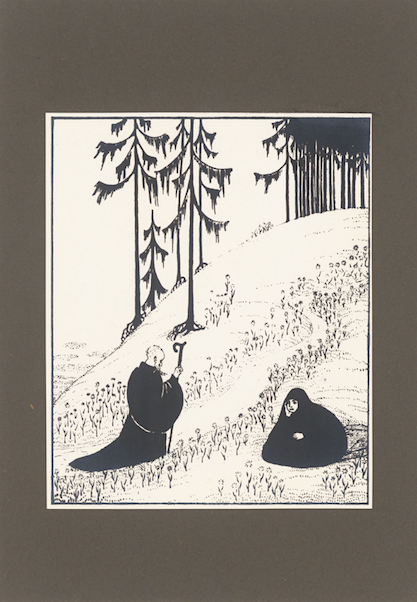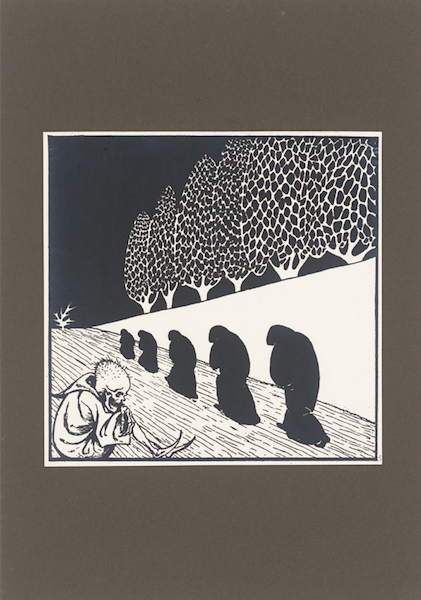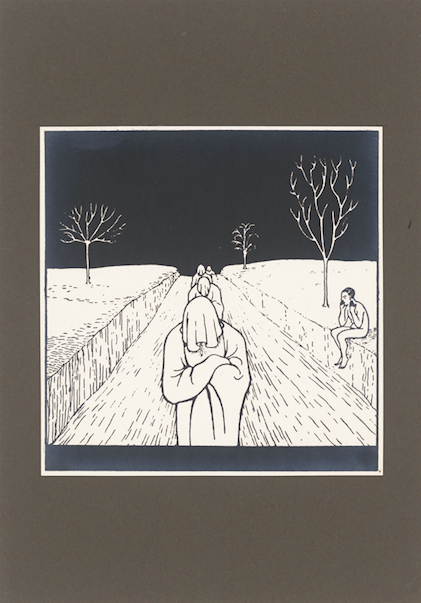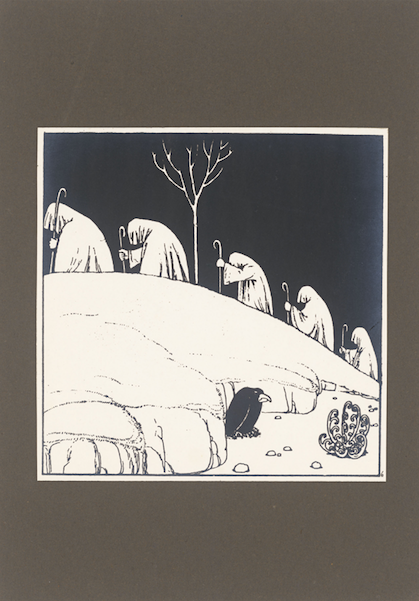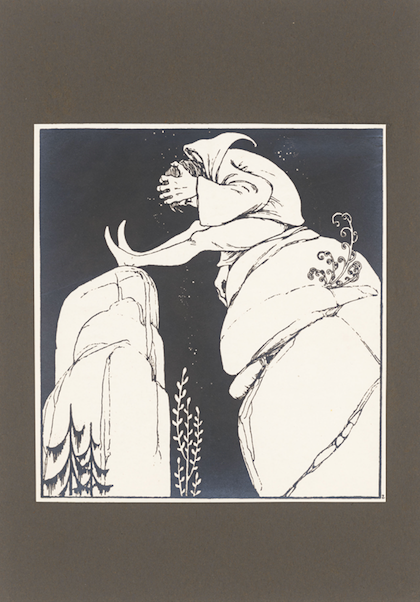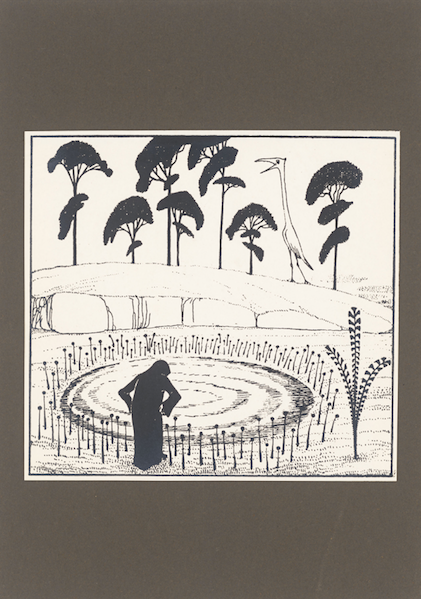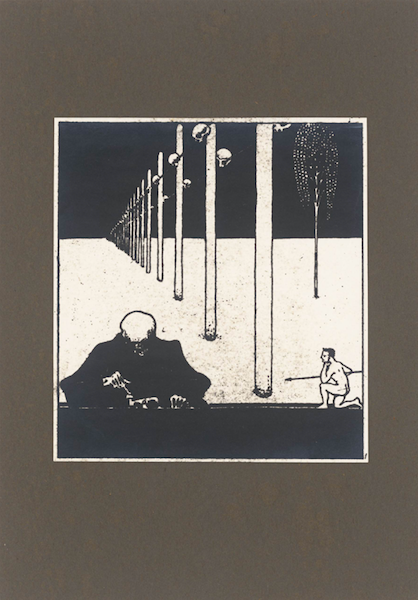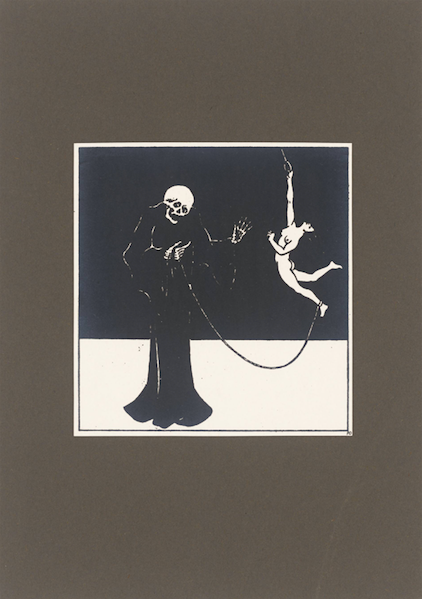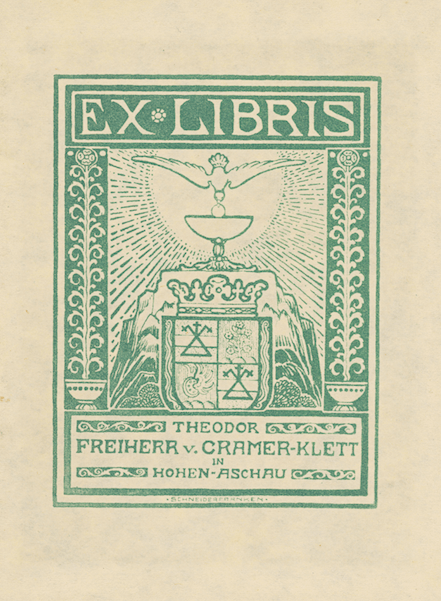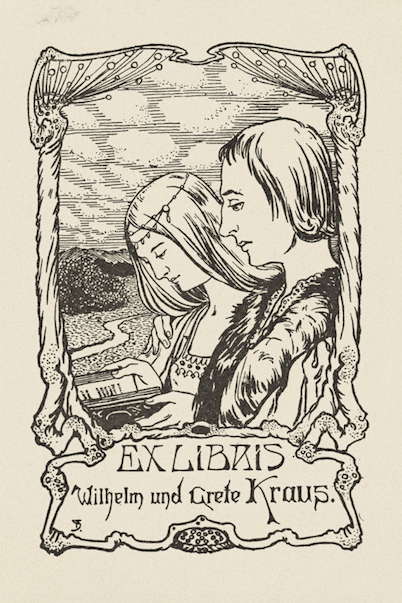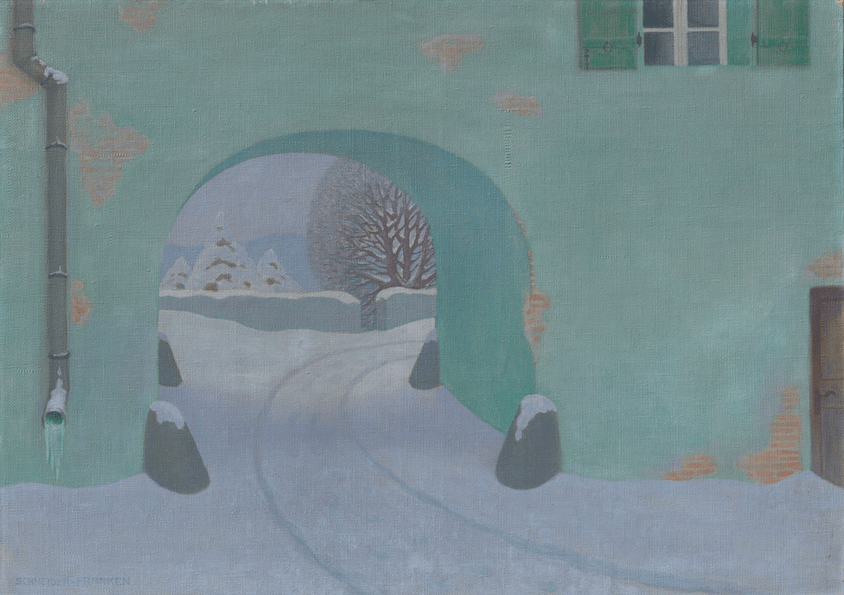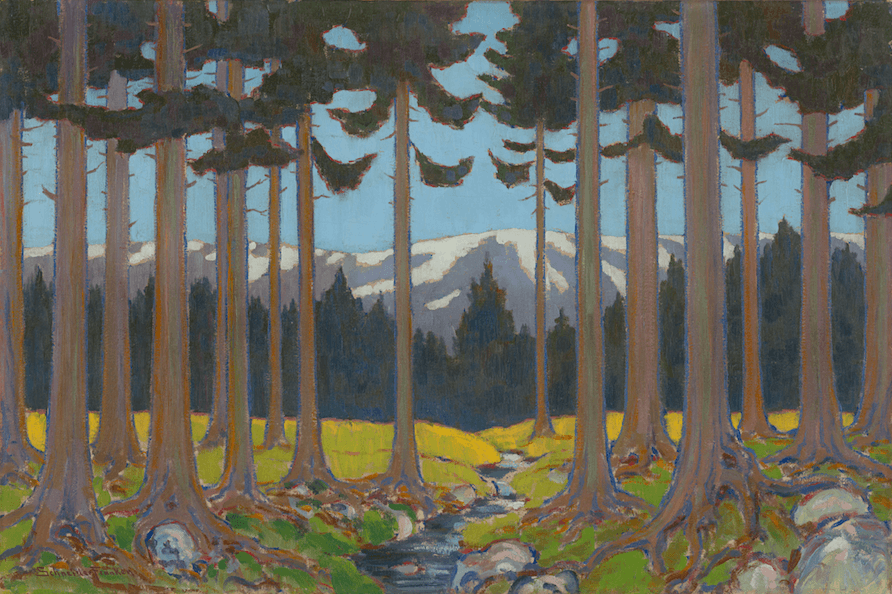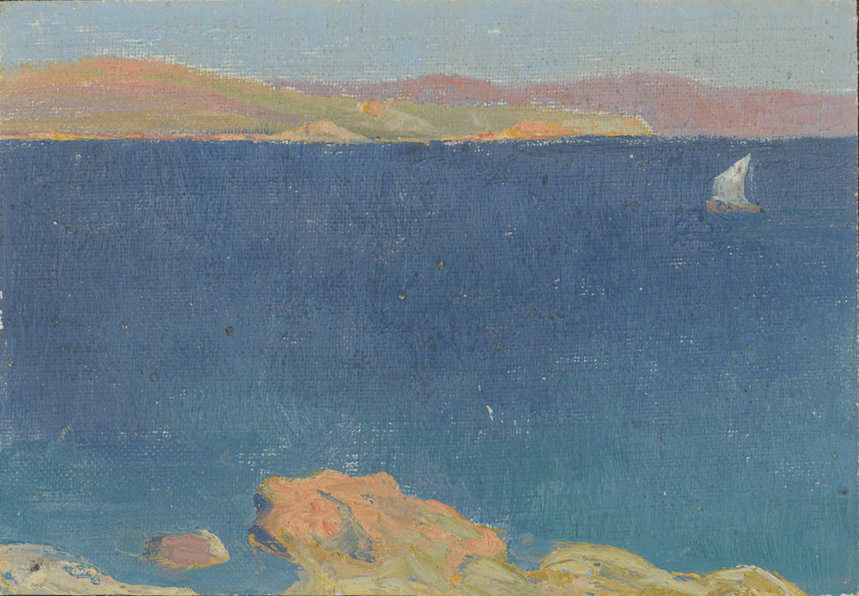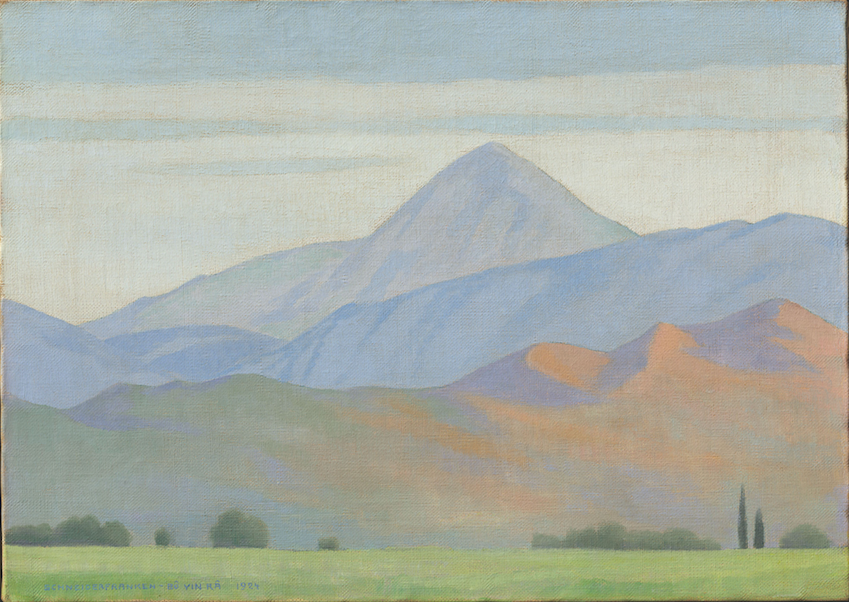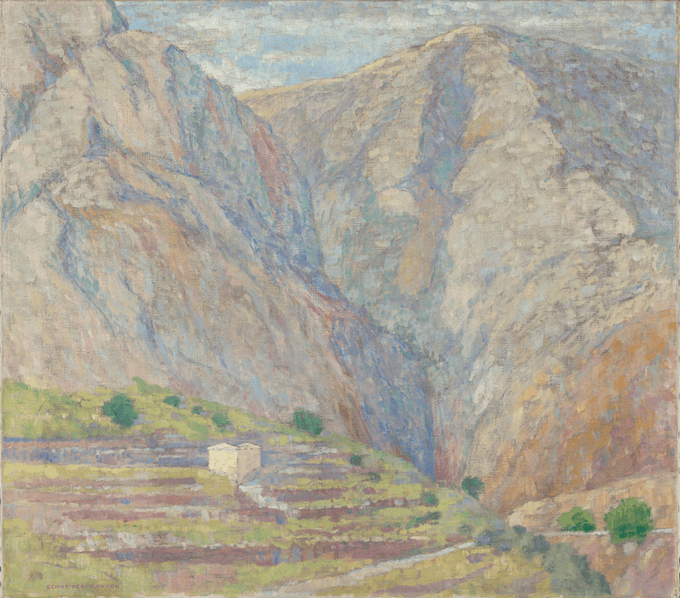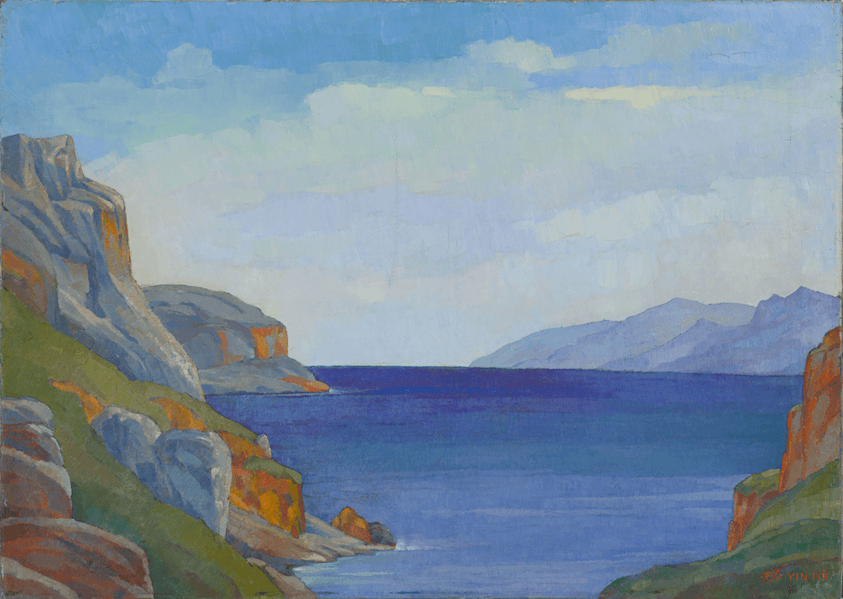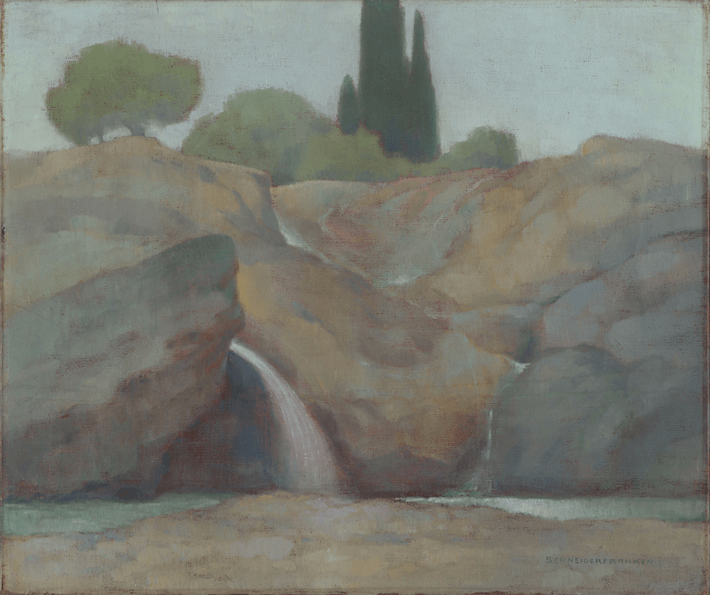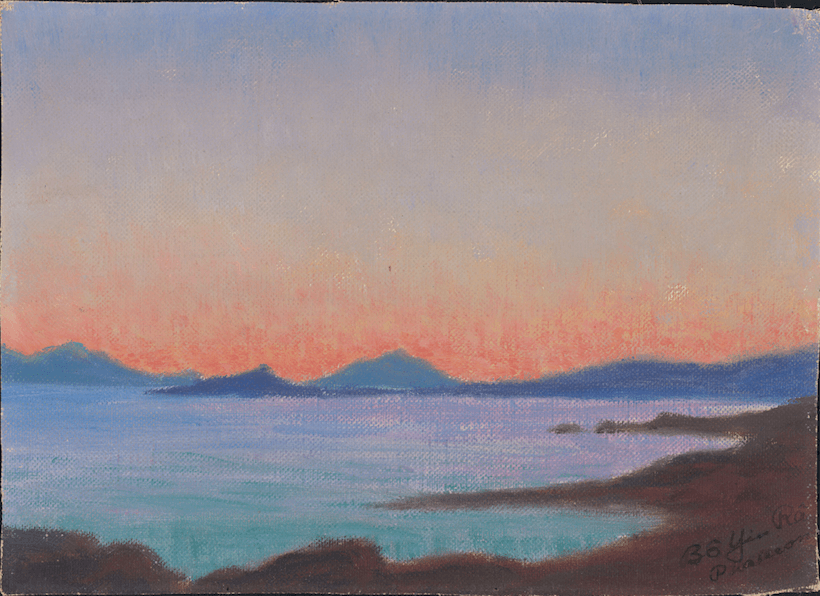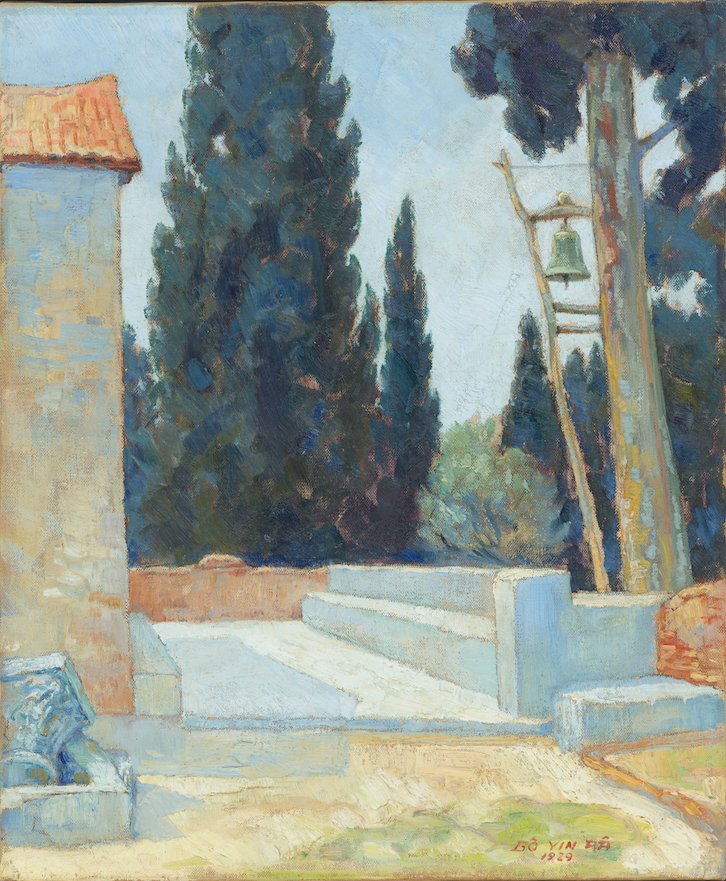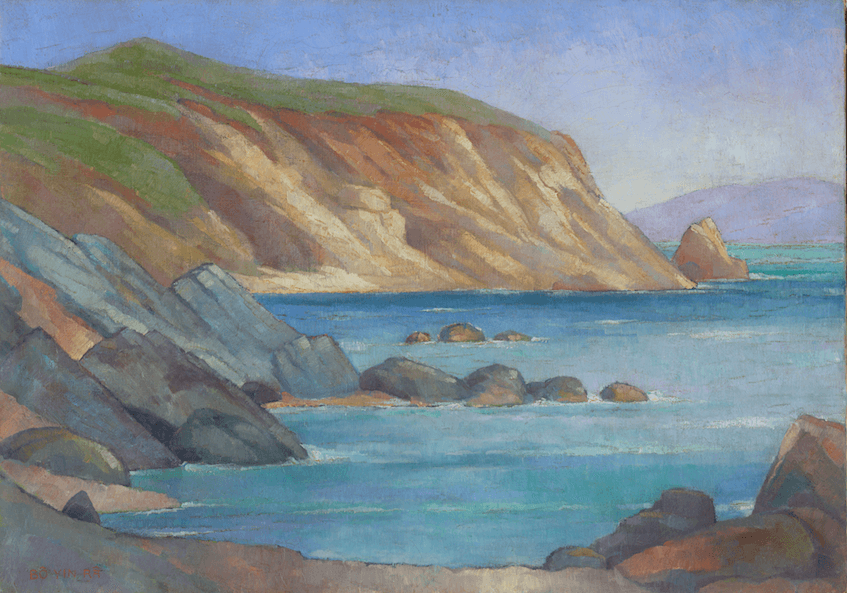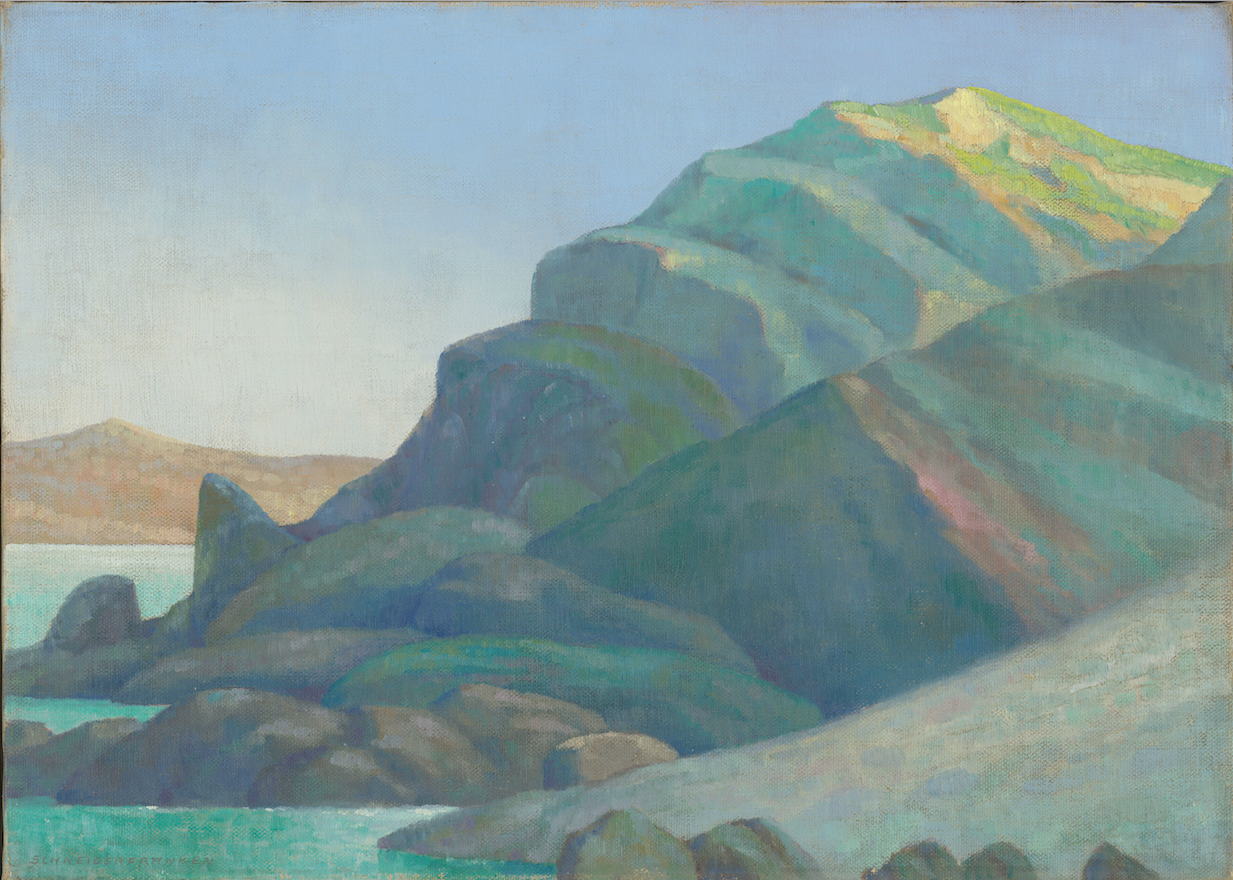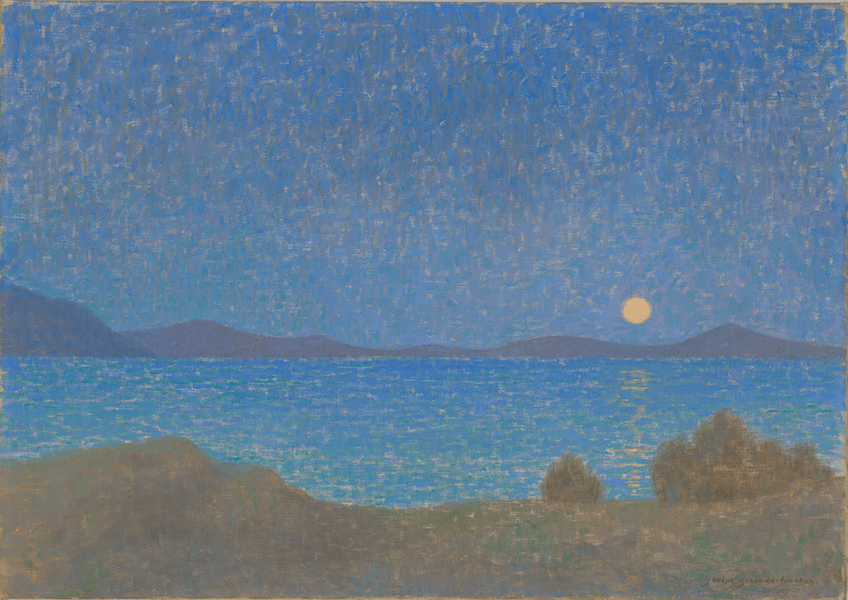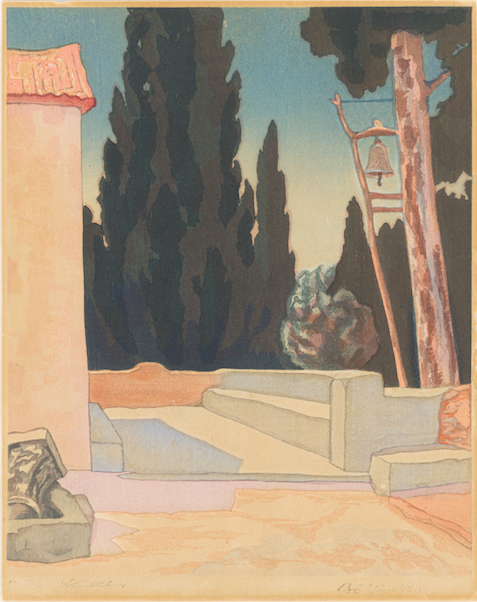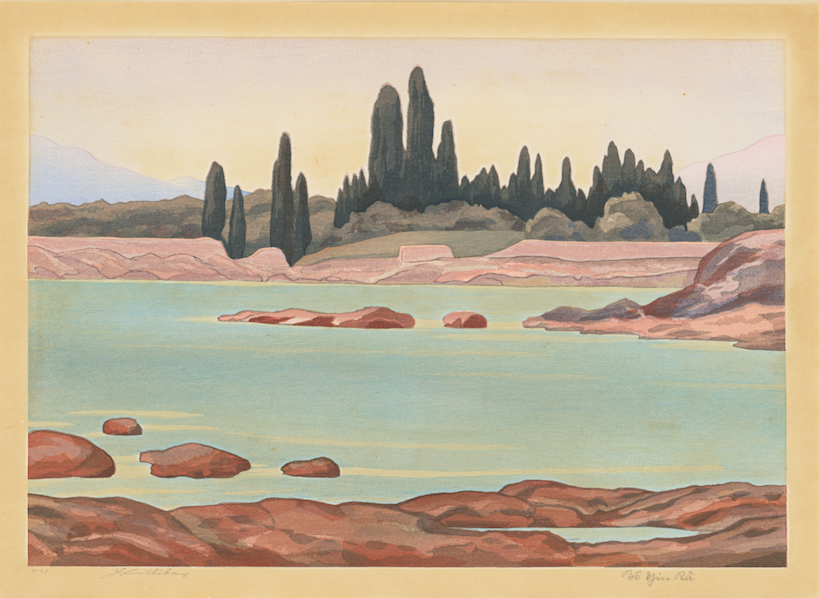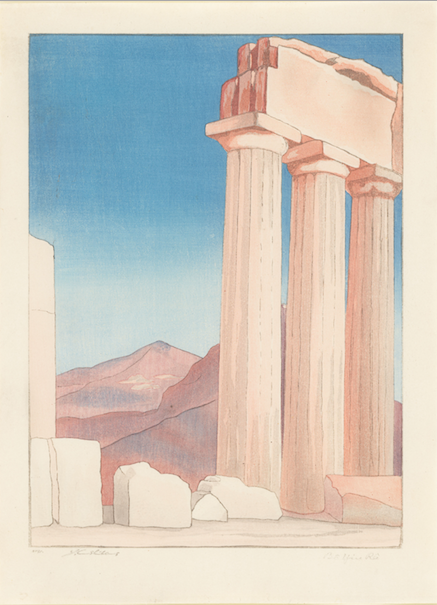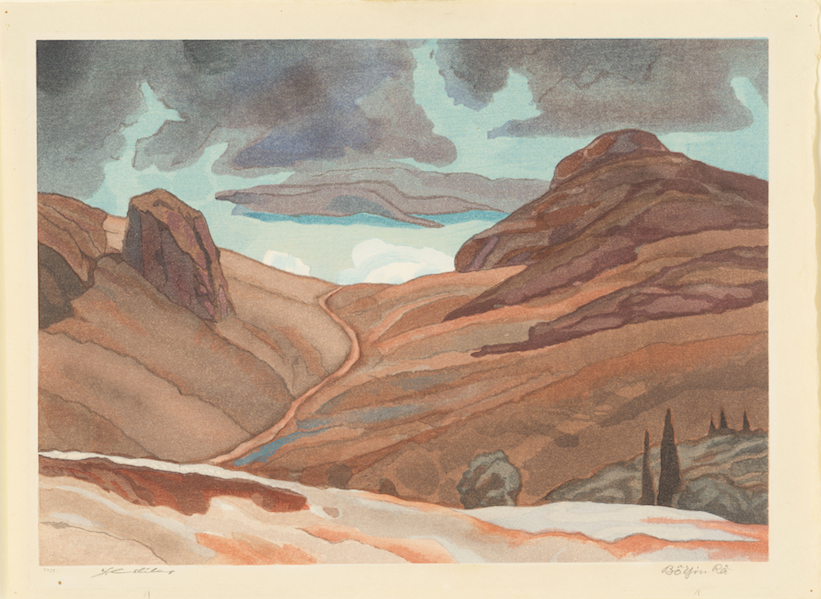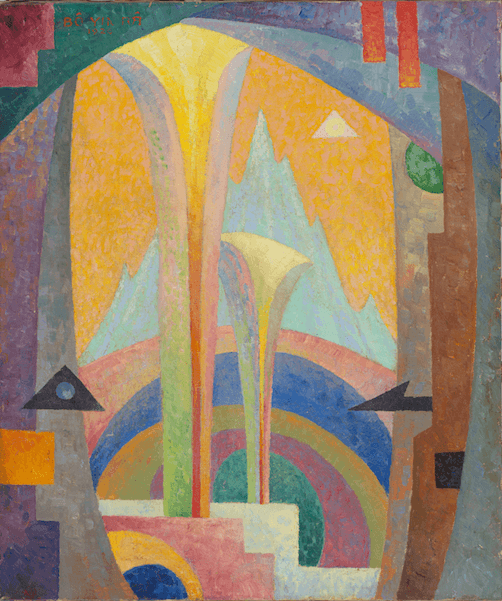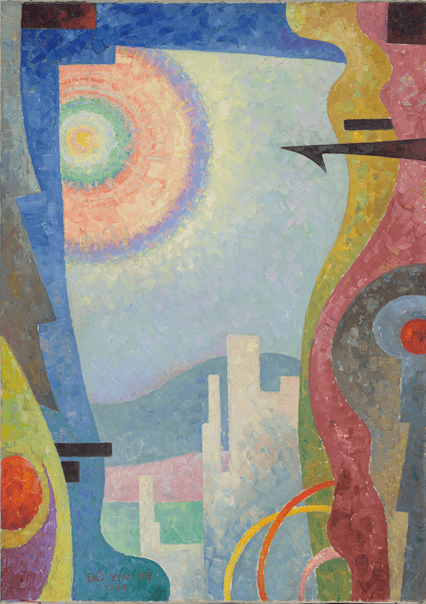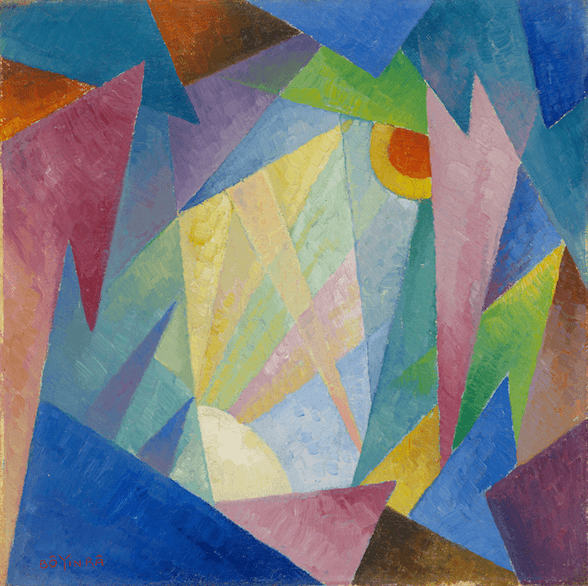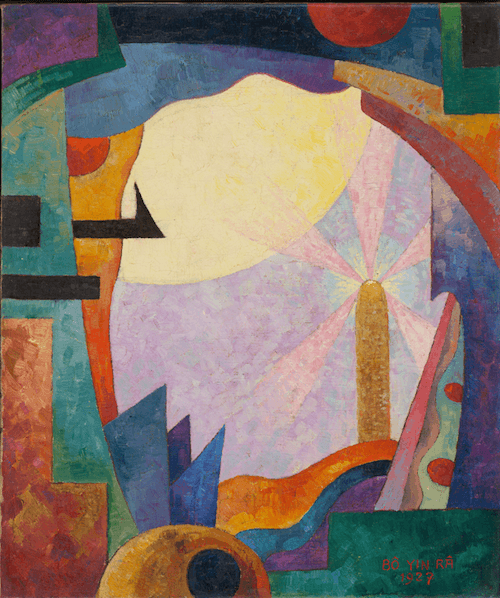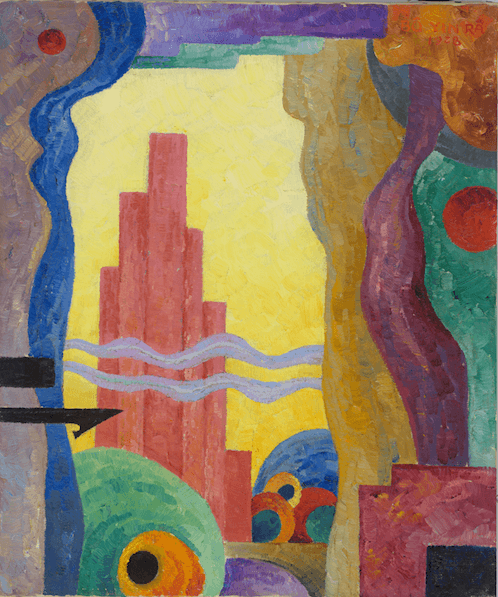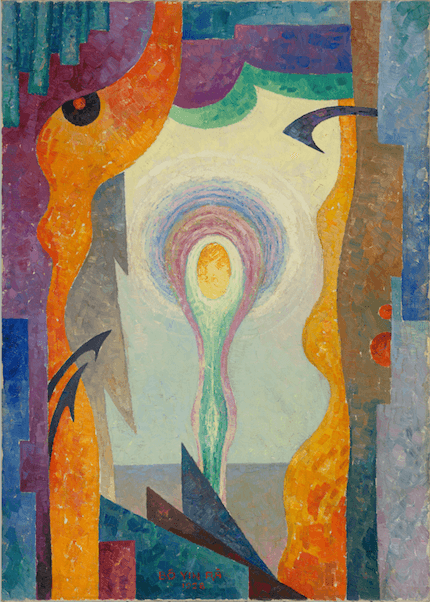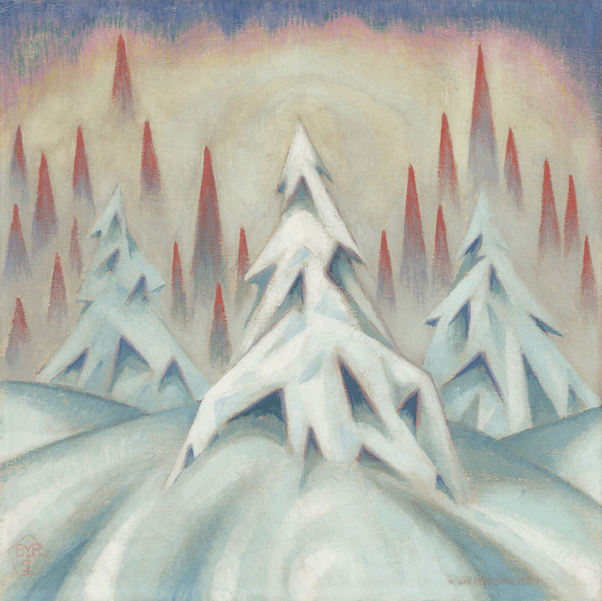CATALOGUE RAISONNÉ
A specific focus of the foundation is the creation of a catalogue raisonné, especially of the pictorial works. As far as we know a complete works catalogue does not yet exist and shall contain all the writings published by the author, as well as all works of fine art by the artist’s own hand.
The ultimate goal of the catalogue is the preservation of the work itself – as faithfully and completely as possible. The Bô Yin Râ Catalogue Raisonné will therefore be not just a list of titles but, primarily, an archive with reproductions in both word and image. It is planned to keep you informed of the project’s progress.
ARTWORK ARCHIVE
The following paintings have been digitized by the Deutsche Bô Yin Râ-Stiftung, and we make them – landscapes and, above all, spiritual images– available here for meditative viewing on the screen.
However, the original fidelity of the high-quality image files in the emerging artwork archive, each approximately 1-2 GB in size, cannot be fully appreciated on a screen. On typical monitors, one would not discern any advantage of the original data compared to the web files, which are reduced in color depth and resolution. This is due to the limitation of 8-bit color depth, lower resolution, and, above all, the lack of color calibration on standard monitors. Tinkering around with brightness, color saturation, color temperature, and the like on screen or in image-viewing software only adds to it.
It can be generally stated that a physical reproduction illuminated by daylight is inherently closer to the original painting than a self-illuminating, digital image, which requires darkness to achieve its optimal effect.
Most will also achieve a more undisturbed devotion with tangible, 'hands-on' images rather than on a computer, which tends to demand its own attention. As a result, we regard the art prints as the goal of the artwork archive, and the digital data as a means to that end.
FINE ART PRINTS
We are therefore delighted to present these paintings as high-quality fine art prints, made available through Verlag Magische Blätter. Further information about the prints can be found there.
With these art prints, you can trust that the colors and details remain true to the originals, ensuring the paintings appear as the artist intended.
PREFACE TO THE PRESENTATION ON THIS WEBSITE
Although the possibility of creating a more permanent, physically anchored reproduction of the artworks is the primary motivation for establishing the artwork archive, the ‘apparent’ images prepared for screen viewing are not meant to be concealed.
Texts have been provided with the images below, and the sole aim of this foreword is to clarify their intended context – and, even more, to ensure how they must not be misconstrued.
In his book The Realm of Art (from the chapter 'Art Explanation,' as well as the following quotes), Bô Yin Râ writes, in essence, that nowhere is the fundamentally mistaken understanding by many of a visual artist’s creative work more clearly revealed than in the demand that art must be "explained." That which can be expressed in words – cited here in essence and abbreviated – never truly concerns art as such.
To s e e, to see, and to see a g a i n...
– u n d e t er r e d by one's own prejudices, preferences, or aversions
– guided only by the desire, with open eyes and all the powers of empathy,
to seek to discover the inner 'organic' l i f e within the artwork
– this is the only advice one can give to anyone...
'Explanation' is therefore exactly not the purpose of the accompanying texts, and this note is directed equally at those who seek an explanation as a basis for their judgment of the artwork or as a shortcut to their own engagement with it, as well as at those who have internalized Bô Yin Râ's insights into the nature of art and now react with rejection to any kind of communication about an artwork, assuming that something should be explained to them.
Why not simply line up the pictures without words?
What we hope for from the accompanying words is similar to the function of an attractive gift wrap. The gift wrap marks the content as something special and distinguishes it from its surroundings. The slow unwrapping brings thoughts, previously scattered in the everyday, to a state of focus. When the gift itself stands before us, hardly anyone would judge its value based on the wrapping paper, nor would they see the now-set-aside packaging as an obstacle to using the gift for its intended purpose.
An occasional sentence about the milestones the artwork has gone through since its creation may offer a glimpse of the joy of being able to view this painting here and now, as if on the first day. This is far from something to be taken for granted, and a silent gratitude to the unnamed owners, both past and present, who have honored the painting over decades, preserved it in difficult times, and, ultimately, returned it to the world through their consent to its reproduction, will not disturb the subsequent immersion in the artwork.
Details about the time and place of the motif’s creation, which cannot be inferred from the image alone, establish a connection to biographical events that the artist himself deemed noteworthy in his writings. Whether and how this knowledge stimulates the viewer remains entirely up to them. Other information has served its purpose if it prevents the mind from indulging in fruitless speculation, thereby contributing to an openness for grasping the essential. In a few cases, when the verbal addition refers to the visual representation, it does so only with the intention of encouraging the recipient to engage in their own, deeper contemplation:
I d e a s that can be grasped by the i n t e l l e c t or expressed in words
may elevate and inspire the soul, but they are never capable
of replacing the inner l i f e of the forms and colors united in a work of art.
To elevate and inspire the soul: this is no small feat, but even a small gain can only be achieved under the condition that one does not expect the impossible from the ideas expressed in words: the key to the inner life of the artwork.
* * *
Technical Notes
Dimensions: The dimensions given indicate height × width in cm and refer to the original size.
Technique: All works executed in oil on canvas are assigned to the secular and spiritual paintings; all others are grouped under drawings, even if a few individual pieces do not strictly belong. The technique used is indicated in the text accompanying each work.
Literature: The lecture 'Symbolform und Wirklichkeit in den Bildern von Bô Yin Râ' (Symbolic Form and Reality Itself in the Paintings of Bô Yin Râ) as well as the books 'Der Maler Bô Yin Râ' (The Painter Bô Yin Râ) and 'Griechenlandskizzen' (Sketches of Greece) by Rudolf Schott are available from Kober publishing.
Image View: Click on the thumbnails to view higher-resolution images. On most systems, you can switch to full-screen mode (and back) using the F11 key on a PC or Ctrl-Cmd-F on a Mac.
Download: If you wish to download the images, please use the zipped folder, otherwise, the correct file names will not be transferred.
Would you like to download the images now?
Image Rights: Please note that only private use of the image files is permitted (Copyright). While purely private use does include printing the reduced files provided here for on-screen viewing, it is a pity if you settle for that alone. The quality difference compared to the art prints is substantial. Further details can be found in this document, including in the pricing chapter.
Call for Support: Those who wish to contribute to the work on the artwork archive to make more of Bô Yin Râ's paintings accessible to the public will find some suggestions in this call.
AUS DEM TRAUMLAND (From Dreamland)
> Click the image to view individual pictures
Dimensions of Drawings:
1. Dreamer and Realist 16,1 x 14,9
2. The Self-Tormentors 19,1 x 15,8
3. Tired Souls 16,1 x 16,4
4. The Quietest Path 16,8 x 16,5
5. The Path of the Accomplished 17,0 x 17,7
6. The White Path 17,1 x 16,9
7. Doubt 18,2 x 16,9
8. At the Dream Source 16,9 x 18,2
9. In the Land of Certainty 16,6 x 15,2
10. Joke infinto 14,1 x 13,4
Date Taken: April 24, 2022
From Dreamland is a series of ten (most likely) pen-and-ink drawings that were reproduced and published in 1906 by 'Berlin Verlag,' along with a preface and table of contents. However, the images shown here are not based on the original drawings or the 1906 portfolio but on a photographic reproduction from at least the 1920s, as indicated by paper analysis. The white photographic papers are affixed to A4-sized cardboard at their upper edges and are enclosed in a folder of the same color as the cardboard.
It is remarkable that this
Result of the Night
came into being at the same time as the first spiritual paintings and the initial drafts of the teaching work texts, as indicated by
the
text accompanying the
Worlds
paintings.
In the obituary for Max Klinger from 1920, Bô Yin Râ writes,
I nevertheless only dared to present to the public two portfolio works
[note:
From Dreamland, Phantasies]
of purely symbolic content at that time
[note: 1906]
and did not draw attention with my color-symbolic
[note: spiritual]
works
...
In 1922 and 1923, drawings of a similar nature were also published in the journal 'Der Türmer' (Magische Blätter, July 2022, pp. 335 and 337).
In his autobiographical book My Work as a Painter, published in 1932, these works are not concealed but their significance is put into perspective:
... just as I at times sought to shape various, more p o e t i c moods
into sequences of black-and-white drawings.
Yet such attempts were always swiftly subdued and erased within me,
even if they brought me relatively greater recognition and encouragement
than my innate, essential striving toward a state wholly at rest in itself,
realized solely through the spiritual values of its forms and colors – an ‘i m a g e.’
EXLIBRIS CRAMER-KLETT
Dimensions: 10,0 x 7,5
Sheet Size: 14,1 x 10,5
Date Taken: April 27, 2022
An ex libris (bookplate or book owner's mark) is a sheet pasted into a book to indicate its owner. Ex libris emerged soon after the invention of the printing press and have inspired prominent artists over the centuries. According to the introduction to the ex libris catalogue of the Gutenberg Museum Mainz, which is the largest catalogue of its kind in the world with approximately 49,000 entries, ex libris experienced its first flourishing from the end of the 15th century to the 17th century. However, the golden era was during the years 1890–1925. During this period, Hans Thoma and Max Klinger are foremost among the artists who set standards in ex libris design. Both Thoma and Klinger had a personal relationship with Bô Yin Râ.
This ex libris is cataloged there under number 40610.
EXLIBRIS KRAUS
Dimensions: 10,1 x 7,6
Sheet Size: 14,1 x 10,5
Date Taken: December 6, 2021
This ex libris is described in the ex libris catalogue of the Gutenberg Museum Mainz under number 10027, which confirms its authorship. Additionally, the artist's monogram can be found in the lower left corner. In 1906, Bô Yin Râ published the series Phantasien, consisting of 20 symbolic pen drawings, through the Berlin publishing house 'Wilhelm Kraus'. It is reasonable to assume that the creation of this ex libris also dates to around that time.
Note: In the reproduction of this print an ink spot has been retouched outside of the drawing at the top left.
BELEBTE LANDSCHAFT (Lively Landscape)
Dimensions: 13,8 x 14,2
Sheet Size: 16 x 17
Date Taken: November 19, 2025
The watercolor was auctioned in November 2022 under the name assigned by the auction house, “Weite Landschaft” (Wide Landscape), and shipped as “Surreal Landscape”. On the reverse, the sheet is inscribed with “SCHNEIDERFRANKEN” and the number 01689. Although there is now little to argue against Bô Yin Râ’s authorship, a small question mark remains. Previously, we were not aware of any reproductions of watercolors by Bô Yin Râ; however, in the December 2023 issue of Magische Blätter, p. 124, an article appeared about an exhibition in May/June 1976 at the Swiss National Library, in which “Watercolors from the Early Years” by Bô Yin Râ were on display. In the March issue of the same year, on pp. 196 and 219, circumstances were discussed that could make the number on the reverse, and thus also the authenticity, plausible.
The name we propose, Belebte Landschaft (Lively Landscape), can, at first glance – by those who reject any further interpretation – simply be understood as a reference to the living beings depicted in the landscape, a rare exception in Bô Yin Râ’s work, which thus leads to a more specific designation of the painting.
The title may also be related to the inner life perceived by the churchgoers in the background – perhaps elevated in spirit by the service – which they experience within themselves and project outward into the landscape. The halos around the sun and moon, as well as the toll of the bell, point to an experience of the physical phenomena illuminated through inner perception. The two groups in the foreground – three standing figures and two passing by with a donkey – recall biblical scenes and, from this perspective, appear to belong to the imaginative world that enlivens the landscape, which their translucent form and supernatural size in relation to the buildings in the foreground suggest. Even the tree skeletons actually protruding from the cemetery resemble hands reaching toward the light.
E.V. STEINLE
Dimensions: 35 x 29
Date Taken: December 6, 2021
This drawing by the 16-year-old from 1893 at the beginning of his training at the Städelsche Kunstinstitut in Frankfurt is the earliest known work by the artist,
that we know of.
In terms of technical implementation, it appears to be black and white chalk on light brown cardboard. The signature E.v. Steinle (Edward von Steinle, painter, first professor at the Städelsches Institut) was added later in pencil.
SONNENINSEL (Sun Island)
Dimensions: 23 x 32
Date Taken: December 6, 2021
Melchior Lechter was born in Münster in 1865, and, apart from several trips, lived as a visual artist in Berlin since 1884. A focus of his work was graphics and stained glass windows. An encounter with the young Joseph Anton Schneider during his time in Berlin is likely as unknown as this pencil drawing. It was acquired in the 1990s by a Munich collector from the estate of Melchior Lechter on Capri, was auctioned in November 2021 from the Hunsrück, revisited its place of origin in Berlin for the photograph, and is now, for the first time, accessible to a wider audience. The title of the image was not passed down, and the one given here is intended to simply name the obvious without interpretation.
Note: Four spots were subsequently retouched in this reproduction, all outside the pencil frame. The brown spots are mold stains in the paper. (The zipped folder for download also contains the unretouched version.)
WINTERTAG – FINSTERTOR IN GÖRLITZ (Winter Day – Finstertor in Görlitz)
Dimensions: 75 x 106
Görlitz Collections/Cultural History Museum, Inv. No. 2226-2008
Date Taken: April 19, 2024
The painting Wintertag – Finstertor in Görlitz was gifted to the city of Görlitz in 2008 by the artist's daughter. It has been hanging since then in the Görlitzer Kaisertrutz, one of the five exhibition sites of the Kulturhistorisches Museum, and is probably the only painting by Bô Yin Râ in a public museum, and his only one with a motif from Görlitz. The daughter informed that the painting "Winter Day is an artistic representation of the old Görlitz Finstertor, as named by my father..."
The comparison with the actual appearance of the Finstertor, as seen on this postcard with a postmark from 1917, just before the creation of the painting, provides a small glimpse into Bô Yin Râ's artistic work.
Anyone expecting a realistic depiction rather than an artistic representation of inner experience, where the outer appearance merely served as a starting point, might even dispute the connection with the Görlitz Finstertor, as the first impression of the image differs significantly from the original model. However, a second look reveals that the artist incorporates and artistically elaborates on most of the characteristic elements of the place in his depiction: positioned at the edge of the field of view are the cassette window with its shutters (the latter having been restored since, but missing on the postcard), the door, and the downspout; along with the crumbling plaster and the rare curve of the path through a city gate, highlighted by the traces of wheels. The protective bollards in front of the gate arches are still present on the rear side of the gate. The round arch, instead of the pointed arch – a noticeable alteration of the motif – corresponds to the bend in the path, and a spring-like greenish tinge, another artistic addition, rests on the gate. The adjacent hoof or footprint marks beside the wheel tracks under the archway seem to suggest a pause before entering the brighter side. The forbidding, impenetrable cemetery wall on the left, which continues behind the Finstertor above the rampart, is transformed by Bô Yin Râ into a permeable, low parapet that opens up the view to the lands beyond. A deep calm envelops the frozen scene; only the traces of the passerby and the presence of a person from the recently past romantic era might find the theme of death, associated with the adjacent cemetery, symbolized in the season of its name – though without the attribute of darkness usually associated with this theme.
The Finstertor is only a few meters away from the grave of Jakob Böhme, to whom Bô Yin Râ dedicated a chapter in his book
Signposts Along the Way.
WALD IM RIESENGEBIRGE (Forest in the Giant Mountains)
Dimensions: 60 x 90
Date Taken: November 16, 2020
Caption on the frame is by Bô Yin Râ himself:
Joseph Schneiderfranken "Wald im Riesengebirge".
In Rudolf Schott's book 'Der Maler Bô Yin Râ' (The Painter Bô Yin Râ), the painting is listed only as Im Riesengebirge (In the Giant Mountains). However, it is not included in the first edition from 1927, which the painter reviewed.
Starting on August 11, 1919, the painting was exhibited along with other works in the Memorial Hall in Görlitz, according to the Niederschlesische Zeitung of August 12, 1919 (Magische Blätter, March 2021, p. 179). The newspaper article also refers to it as
Wald im Riesengebirge.
This has prompted us to publish it again under its original title.
MEERLANDSCHAFT MIT SEGELBOOT
(Seascape with Sailing Boat)
Dimensions: 13 x 19
Date Taken: October 7, 2021
This small image sketch is already known from the book 'Griechenlandskizzen' (Sketches of Greece) by Rudolf Schott, which contains 22 sketches in their original size and high image quality. According to the detailed introduction, the Greece sketches were made on-site in 1912/1913 "with the intention of later developing them into larger landscape paintings." Owing to the painter’s many commitments, this unfortunately did not happen on many occasions, including in this case.
ABEND AUF KORFU
(Evening in Corfu)
Dimensions: 60 x 100
Date Taken: November 18, 2020
The title
Abend auf Korfu
appears on the stretcher frame to which the canvas is attached, and can therefore be considered verified.
DER OSSA IN THESSALIEN (2)
(The Ossa in Thessaly 2)
Dimensions: 50 x 70
Date Taken: November 19, 2025
The painting’s title is preserved in the artist’s own handwriting on the back of the frame, and is therefore authentic. Bô Yin Râ gifted the painting to the translator of his writings into Dutch, in whose circle it was carefully preserved until January 2025.
This artwork, signed with the year 1924, differs only slightly from its predecessor of the same name, which was exhibited in Görlitz in 1919 (catalogue
booklet of the Görlitz exhibition). That they are in fact two different paintings is evidenced, upon closer inspection, by the clouds, the trees in the foreground, and the slightly differing image section (see the
comparison
in the
June 2023 issue of Magische Blätter, p. 129). A clear difference you will find between the earlier photograph and the mountain ranges of the original, immortalised in quiet grandeur with a previously imperceptible richness of colour, which are now made accessible to you as a faithful fine art print.
DELPHI (2)
Dimensions: 75 x 85
Date Taken: November 18, 2020
The name was newly assigned here due to the lack of historical records.
There is a smaller image with a very similar motif, which is likely the on-site sketch for this painting. To differentiate it, the designation number 2 has been added. A preliminary sketch with black pencil is visible under the painting. The painting is in the same condition as when it was created and was cleaned before digitization. The fine color nuances are now visible again, which had previously been obscured by heavy surface dirt.
The painting depicts the site of the Sanctuary of Apollo in Delphi, viewed approximately from the village's exit. The small building is the restored Treasury of the Athenians. Only the foundations of the Apollo Temple behind it, which housed the Oracle of Delphi, remain. Above the entrance of this sacred temple at that time was the inscription “Know thyself!” – a quote cited by Bô Yin Râ in the book
Worlds of Spirit
and in The
Book On The Royal Art.
The references provided by the author suggest that the encounter described in the chapter
Magic
from The
Book Of Dialogues
took place here.
GOLF VON ITEA (1)
(Gulf of Itea 1)
Dimensions: 50 x 70
Date Taken: July 26, 2024
The name is confirmed by an inscription on the stretcher, and it is likely the same painting exhibited in 1919 under the title Morning at Itea at the previously mentioned Görlitz exhibition: The long shadows of the mountains are consistent with the time of day depicted, and the only other nearly identical painting from Itea, signed "Bô Yin Râ 1929," is also known. The Gulf of Itea extends below Delphi.
The painting has a turbulent history: According to historical accounts, it was purchased from a dealer in Zurich in 1935, emigrated with its owners to the USA in 1942, spent many years in New York, was passed down to Montreal in 1997, and returned to Germany in 2024.
FRÜHLINGSTAG AM GOLF VON ARGOS
(Spring Day on the Gulf of Argos)
Dimensions: 75 x 105
Date Taken: November 16, 2020
The name of the painting is written in Bô Yin Râ's handwriting on the back of the stretch frame and therefore seems authentic.
To reach the location where the painter was positioned, hike south from Nauplia (pronounced Nafplio in modern Greek) to Arvanitia Beach, then continue southeast along the footpath towards Karathona Beach.
Note: The original today shows some vertical streaks in the horizontally layered water surface, which have been minimized in the reproduction with the smallest possible intervention in the image data. These vertical structures are not part of the artist's original design but occurred later. The zipped folder for download also contains the unretouched version.
We assure that no digital restoration has been performed without such a note.
ASKLEPIEION ZU ATHEN (2) (Asklepieion in Athens 2)
Dimensions: 76 x 86
Date Taken: June 23, 2021
The depicted Asklepieion zu Athen is situated on the southern slope of the Athenian Acropolis, with the Philopappos Hill in the background. In Schott's book 'Der Maler Bô Yin Râ' (The Painter Bô Yin Râ), from which we have derived the painting’s title and appended the number 2 for distinction, includes a study of this elaborated work. Very little can be added to the thorough observations provided there.
At the Görlitz art exhibition, which opened on August 11, 1919, this painting was shown under the title The Ruins of the Asklepieion (Athens). In 1929, it was acquired by Prince Heinrich of Schaumburg-Lippe, who was personally acquainted with Bô Yin Râ (Magische Blätter, December 2020, pp. 211f). The painting was later located in Madrid and was not publicly viewable again until June 2021, when it was exhibited at an auction in Berlin. Although it was auctioned under the name 'The Ruins of Kos' – which would also refer to an Asclepius Sanctuary – we consider this location unlikely given Schott's book and the known places where the artist resided.
The signature is also noteworthy. With a creation year of 1913, it is the earliest clearly dated painting featuring the full spiritual name. Since Bô Yin Râ indicates in
Concerning My Name
that he first used his full spiritual name when signing works at the time of the publication of
The Book On the Living God
in early 1919, it suggests the possibility that the signature was added later, possibly in connection with the Görlitz exhibition.
DER FELSENQUELL
(The Rock Spring)
Dimensions: 49 x 58
Date Taken: November 16, 2020
The frame on which the canvas is mounted bears the signature Joseph Schneiderfranken and the words 'Bô Yin Râ, Der Felsenquell.` – the latter, however, is unlikely Bô Yin Râ's own handwriting. The name of the painting likely comes from Bô Yin Râ himself.
The rare red priming of the canvas by Bô Yin Râ is particularly noticeable in the areas where water flows out, which, despite the ample light, does not produce any green.
The motif could not be identified for a long time until, in April 2024, a catalogue booklet from the 1919 Görlitz exhibition, listing the names of all 66 landscape and flower paintings shown, was discovered in the archives of the Görlitz Collections for History and Culture. There is a work listed as Die Quelle Kallirrhoe (The Spring of Kallirrhoe), and there is substantial evidence suggesting that this is indeed the same painting. No other painting by Bô Yin Râ featuring a spring is known, and the pages of the German Archaeological Institute display a photograph of the Spring of Kallirrhoe, which bears a striking resemblance to Der Felsenquell. It notes, "The spring is located in Athens, southeast of the Olympieion in the riverbed of the Ilissos, opposite the church of Agia Photini, where it released a significant amount of water at the base of a steep cliff until 1962." This is directly south of the Temple of Olympian Zeus (Olympieion), which Bô Yin Râ also painted.
However, highlighting the name and location of the spring does little to set the mood for the artwork in this case, which may have been a reason for its later renaming.
PHALERON
Dimensions: 19 x 26
Date Taken: October 7, 2021
The Bay of Phaleron (today Paleo Faliro), located six kilometers southwest of the Athenian Acropolis, was the site of the harbor of Athens during Greek mythology. A comparison of maps suggests that the view depicted is to the west. Behind the viewer would be Cape Kolias (now Agios Kosmas), an area where Rudolf Schott identified another painting motif in his book 'Der Maler Bô Yin Râ' (The Painter Bô Yin Râ). Beyond the dark blue landmass lies the modern port of Piraeus, and in lighter blue, the mountains of the island of Salamis are discernible.
The sunset glow, the interplay of sunlight with earth dust and water vapor, seems to blaze like flames upon a closer look, creating a sea of fire between heaven and earth in this composition of fire, water, earth, and air.
Dimensions: 60 x 50
Date Taken: February 27, 2025
The stretcher frame of the painting bears a pencil inscription in the artist’s own hand:
Bô Yin Râ "Das Glöcklein"
(Solitary church near Karystos on Euboea.)
Rudolf Schott devotes an extensive discussion to this tranquil midday scene, conducive to contemplation, which was created only in 1929 – sixteen years after Bô Yin Râ’s stay in Greece – in the second edition (1960) of his book 'Der Maler Bô Yin Râ' (The Painter Bô Yin Râ).
FELSEN AN DER GRIECHISCHEN KÜSTE (Rocks on the Greek Coast)
Dimensions: 90 x 125
Date Taken: November 14, 2025
This monumental work is the largest so far in the collection presented here and certainly also one of the better-known, as it is part of the selection honoured in Rudolf Schott’s book 'Der Maler Bô Yin Râ'.
FELSENKÜSTE AUF DER INSEL SYRA (2) (Rocky Coast on the Island of Syros 2)
Dimensions: 61 x 86
Date Taken: April 11, 2024
The coast, here glowing in countless color nuances, is referenced by Bô Yin Râ in the poem Blessed Island, which, along with the surrounding verses in the book Gleanings, sheds light on the importance of this place in his life.
Until its ‘discovery’ about six months before the photograph was taken, the existence of this painting could only have been known to a very small circle, as no image of it could be found anywhere. The number (2) serves to distinguish it from the sketch of the same title, which is shown in: Magische Blätter, December 2022, p. 106.
From May 4 to November 17, 2024, the oil painting was accessible to the public in the exhibition 'The Seekers – The Art of the Jakob Böhme Association 1920-1923' at the Kaisertrutz in Görlitz.
AM GOLF VON HERMUPOLIS (2) (On the Gulf of Hermopolis 2)
Dimensions: 50 x 70
Date Taken: February 27, 2025
A completely different atmosphere is created by this shaded coastal stretch, lying in the afternoon haze – also on Syra.
Attached to the stretcher frame of the painting is a note in Bô Yin Râ’s handwriting, bearing the inscription:
Tr... am Golf of Hermupolis (Insel Syra).
Due to a torn-off section, the first word of the title is no longer legible.
Rudolf Schott’s book 'Griechenlandskizzen' (Sketches of Greece) features a sketch with the same title as this painting, to which we again add the reference number (2) for differentiation.
It is likely that this painting was also displayed in the already frequently mentioned Görlitz exhibition in 1919, presumably under the name
Rocks near Hermopolis. (Catalogue booklet
of Görlitz exhibition).
MONDAUFGANG ÜBER DELOS (Moonrise over Delos)
Dimensions: 60 x 84
Date Taken: November 16, 2020
On the back of the frame Bô Yin Râ has written in blue:
Mondaufgang über Delos
Made in 1913 Schneider-Franken
The name and creation date are therefore verified.
If the painting depicts a moonrise, the view must be to the east. Directly west of Delos is the uninhabited island of Rhenia, which is far too close to Delos for this perspective, making it an unlikely location due to its poor accessibility, although it was historically often counted as part of Delos. The painter's location can therefore only be Syra (modern Greek Syros). There are at least two other paintings that show the identical mountain range in the background during daylight.
COLOR WOODCUTS BY YOSHIJIRÔ URUSHIBARA
Evening in Spessart
Dimensions: 30 x 37
Date Taken: August 19, 2022
The Little Bell
Dimensions: 31 x 25
Date Taken: August 19, 2022
Cypress Garden on Euboea Island
Dimensions: 27 x 38
Date Taken: August 19, 2022
Columns of the Parthenon
Dimensions: 30 x 22
Date Taken: April 11, 2024
Winter Day in Attika
Dimensions: 25 x 34
Date Taken: April 11, 2024
These color woodcuts by the Japanese artist and printer Yoshijirô Urushibara (1888-1953) are based on painting motifs by Bô Yin Râ and are signed by both artists. The prints, produced from a single block, can vary significantly in color tone and intensity, and were consecutively numbered.
While the woodcuts do not strictly belong to Bô Yin Râ's oeuvre, they are mentioned by Bô Yin Râ in his book My Work As A Painter (p. 27), which may be of interest to some. Bô Yin Râ writes:
My painting Evening in the Spessart, which the London-based Japanese artist Urushibara
translated into the technique of traditional Japanese color woodcut and presented in his own way,
remains undoubtedly the most f a i t h f u l of all interpretations of my paintings to date.
It belonged to the series of these first works that I have tried to describe here.
(In the meantime, I have created two variations of the same theme,
in which I have granted greater rights to the structure of the painting through the areas of brushstrokes.)
You may form your own impression of the accuracy of the color woodcut 'The Little Bell' by comparing it with the original shown above.
More about Urushibara and his collaboration with Bô Yin Râ can be found in 'Magische Blätter', January 2021 issue, pp. 375f; more about the painting
Evening in the Spessart in the April 2022 issue, pp. 310f.
SCHÖPFUNGSKLÄNGE (Sounds of Creation)
Dimensions: 62 x 52
Date Taken: November 17, 2020
The painting’s title appears in Bô Yin Râ’s handwriting on the back of the frame, and was therefore given by the artist.
The painting is discussed in the book 'Der Maler Bô Yin Râ' (The Painter Bô Yin Râ) by Rudolf Schott.
WELTENFRÜHE (Dawn of the Worlds)
Dimensions: 95 x 65
Date Taken: November 16, 2020
Further details on the painting are available in 'Der Maler Bô Yin Râ' (The Painter Bô Yin Râ) by Rudolf Schott.
LOGOS
Dimensions: 105 x 75
Date Taken: November 17, 2020
The painting’s title, along with Bô Yin Râ’s signature, is written in his handwriting on the back of the frame, and was therefore given by the artist.
The painting is discussed in Rudolf Schott's book 'Der Maler Bô Yin Râ' (The Painter Bô Yin Râ).
DAS ERWACHEN DER SEELE
(The Awakening of the Soul)
Dimensions: 44 x 44
Date Taken: December 8, 2022
The painting's title is transmitted orally and may not necessarily be from the artist himself. Here you see one of the few spiritual works that had not been published before this photograph was taken.
KOSMISCHES ERKENNEN (Cosmic Awareness)
Dimensions: 62,5 x 52,5
Date Taken: August 19, 2022
The painting was sold by the artist in 1932 under the aforementioned name and subsequently went to Brazil, initially to Rio de Janeiro. For almost 100 years, its existence was only known through an unclear black-and-white photograph. In 2019, it could be acquired from the granddaughter of the original owner in São Paulo and is now in private ownership in Germany. Following a successful restoration, it now reveals itself once again in its full richness of color.
MAGISCHE MÄCHTE
(Magical Powers)
Dimensions: 60 x 50
Date Taken: November 17, 2020
This painting’s title, too, was noted by Bô Yin Râ together with his signature on the back of the frame.
UNIO MYSTICA
Dimensions: 105 x 75
Date Taken: November 18, 2020
The painting’s title comes to us from the artist in the same way as with Magical Powers.
VERMÄHLUNG (Marriage)
Dimensions: 65 x 55
Date Taken: November 18, 2020
The painting is simply titled 'Geistiges Bild' (Spiritual Painting) in the frame, but not in the painter’s handwriting.
The title previously given was The Jewel, but also 'Wedding' or 'Marriage'. The name Vermählung is a suggestion by the Deutsche Bô Yin Râ-Stiftung.
Bô Yin Râ painted the work as a wedding gift for a married couple he was friends with, but the shipment was lost in the meantime and only reached the young couple five years later!
WEIHENACHT
(*referring to Christmas)
Dimensions: 48 x 48
Date Taken: March 10, 2021
Rudolf Schott, in his lecture 'Symbolform und Wirklichkeit in den Bildern von Bô Yin Râ' (Symbolic Form and the Nature of Reality Itself in the Paintings of Bô Yin Râ), presumed that Weihenacht is unique in belonging to both secular and spiritual realms. This assumption is supported by the signature in the form of a pentagon, which integrates the initials of both the spiritual and civil names of the artist and is otherwise found only on spiritual paintings.
* The word Weihenacht is referring to Christmas (Weihnacht) and may also be read as 'Night of Consecration',
the word 'Weihe' means consecration in German.
Would you like to download the images now?
ON THE CREATION OF THE WORLDS CYCLE
In the second (1960) and third (1997) editions, p. 126, of his book 'Der Maler Bô Yin Râ' (The Painter Bô Yin Râ), Rudolf Schott writes about the paintings
Worlds: "Bô Yin Râ painted these compositions in Görlitz (approximately 1920 to 1922) for himself and those close to him who understood." This information was valid for many decades.
Based on recent research in the Görlitz archives, the latest possible completion date can be dated to May 1921, as in that month an exhibition of the Jakob-Böhme-Bund (Jakob Böhme Association) in Görlitz – including the Worlds series – was opened. (Magische Blätter April 2020, S. 137ff).
In the book My Work As A Painter (p. 44) by Bô Yin Râ, it can be inferred that the first spiritual paintings were already in the world at a time when expressionism did not yet exist. In his article in the Görlitzer Gazette June 5, 1921 (Magische Blätter, April 2020, p. 140) on the aforementioned exhibition, Bô Yin Râ refers to this timeframe specifically in connection with the Worlds paintings. A similar statement was even included by Bô Yin Râ in the preface to his book Worlds of Spirit (1922). If one dates the beginning of expressionism to the founding of the artist group 'Die Brücke' in 1905, only the first years of the century remain as the period in which the first spiritual paintings were created. Another hint in this direction is found in Bô Yin Râ's obituary for Max Klinger (Gleanings II, Kober-Verlag, p. 63ff), who passed away on July 4, 1920.
Bô Yin Râ writes there that he met Klinger for the first time fifteen years earlier, in 1905, and it is evident from what follows, as well as from the cited chapter of My Work As A Painter, that the first spiritual paintings already existed then, even though Bô Yin Râ only showed them to Klinger in a subsequent meeting. After all, another newspaper article from 1921 was found, stating that the Worlds series were already twenty years old (Magische Blätter, April 2020, p. 232f).
Surprisingly, Schott himself wrote in the first edition (1927) of the aforementioned book, which Bô Yin Râ was still able to review: "Bô Yin Râ painted most of these compositions a long time ago – some almost a quarter of a century ago..." We can now therefore consider it certain that the majority of the Worlds paintings were created shortly after the beginning of the twentieth century, simultaneously with the first, then still hidden, manuscripts of the spiritual teaching work (Hortus conclusus and The Path of My Pupils, each in the final chapter). Furthermore, it can be concluded that the pentagonal signature with the initials of the spiritual name, which Bô Yin Râ only received in Greece in 1912/1913, must have been added later in most cases. In fact, even the illustrations in the first edition (1922) of the book Worlds of Spirit do not yet bear this pentagonal signature.
In the Magische Blätter (Monthly Issue November 2022, p. 28ff), we learn from the Swedish Bô Yin Râ Foundation that all the Worlds paintings were sold to Sweden "around 1920". In the spring of 1952, they were brought to Switzerland, where they remain to this day. In 1956, the second edition of Worlds of Spirit was published by Kober Verlag with new illustrations. Based on the artist's biographical data, it appears that he never saw the Worlds cycle again after the Görlitz exhibition in May 1921.
To the images of the
Worlds
cycle
In conclusion, it should not go unmentioned that all the biographical data on these pages are irrelevant to the reception of the books and paintings – inasmuch as one seeks, through reception, an internalization comparable to the intake of food, which is consumed to experience its effect rather than to analyze its components.
In this comparison with food, the external information provided here would be the packaging – but not with the aim of describing the contents, rather to point to them, so that one may find them!
The biographical details fulfill their purpose if they invite those who do not yet know the author and painter to linger and reflect on whether they wish to partake of this 'nourishment' or not.
Those for whom Bô Yin Râ's work has become a companion in life, and whose interest eventually turns to the earthly path of the creator – even though this is not necessary – may, without laborious personal research, experience how his work came into the world.
CALL FOR SUPPORT
Some paintings are represented by images, but their titles are unknown or uncertain, while other images are of lower quality. Additional works are in private hands or have been lost; some owners are unaware of their significance, while others understandably prefer to remain anonymous due to the uniqueness of each work. Especially in regard to the existing and potentially resurfacing spiritual paintings, it is desirable to make them accessible to a broader audience for meditative contemplation.
After some preparation, Deutsche Bô Yin Râ-Stiftung was able to begin the artwork archive, and thus the catalogue raisonné, by securing the presented paintings. In the process, a workflow was tested – from professional transport and conservation supervision to digitization and printing – that proved successful and can be applied again in the future.
The time is right, and we welcome every owner of a painting who takes the opportunity to enable a digital preservation of their artwork, thereby safeguarding it for present and future generations. We are equally grateful to anyone who brings this call to the attention of a painting owner, as well as for any information regarding artworks appearing on the art market.
Contact us, if you are interested in supporting the artwork archive or have further questions. Your anonymity is assured, and all correspondence will remain confidential.
Finally, for everyone who cares about the painter’s work but does not belong to the small circle with access to an original painting, there is another simple way to support the preservation of these artworks – and thereby the catalogue of raisonné: the aforementioned process chain for continuing the photographic records of paintings and publishing the results is only possible with the help of donations. Those who wish to bring joy to themselves and other readers in this way are warmly welcome to visit Support of our Foundation.



